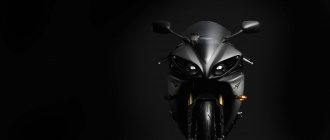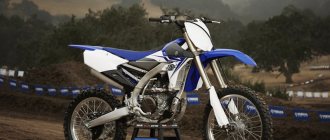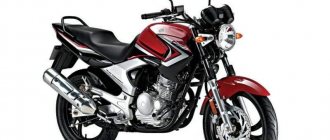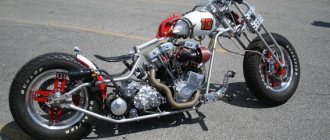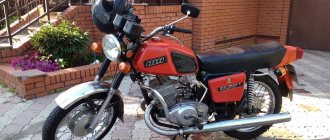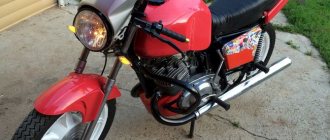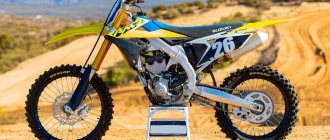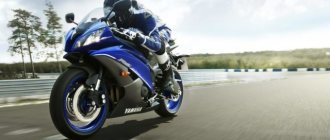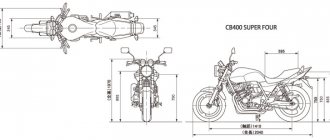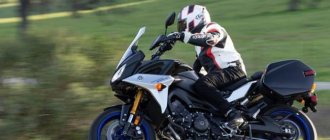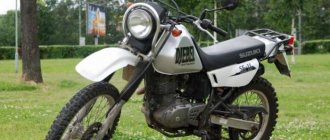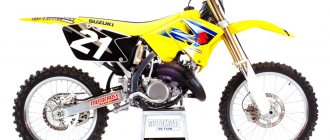| Yamaha R1 (1998-1999) | Yamaha R1 (2000-2001) | Yamaha R1 (2002-2003) |
| Yamaha R1 (2004-2005) | Yamaha R1 (2006) | Yamaha R1 (2007-2008) |
| Yamaha R1 (2009-2014) | Yamaha R1 (2015+) | Yamaha R1M (2015+) |
| Yamaha R1 World GP 60th Anniversary Edition |
Model of the flagship sports motorcycle Yamaha YZF-R1
was first presented on September 15, 1997 at the EICMA exhibition in Milan. This motorcycle became a successor to the Yamaha YZF1000R Thunderace (despite the fact that both models were produced in parallel for some time, the Thunderace began to be positioned on the market as a sports tourer), which received a new frame, a new generation of the Genesis engine, an inverted fork and improved characteristics for track - ergonomics, weight reduction, improved handling, increased engine power.
By 2000, the Yamaha R1 model underwent its first restyling. Despite the fact that there were practically no visual changes, the model was significantly different from the previous generation. The curb weight decreased by 4 kg, the exhaust system became titanium, aerodynamics improved (by 3%), the shape of the windshield changed (for better wind protection for the pilot), the fuel tank received more comfortable recesses for the legs, the seat and position of the footpegs changed (to shift the weight distribution forward ), the engine and transmission have changed: the camshafts received additional oil channels, the pusher clearances have decreased (all this led to a decrease in friction and engine noise), the gearbox has received a completely redesigned switching system (the problem with the gearbox inherent in early versions of the R1 has been resolved).
2002 was marked by the second update of the Yamaha YZF-R1, which consisted of replacing carburetors with an injector and significantly straightening the power take-off curve throughout the entire range of engine operation. The previous generation was distinguished by the fact that from 3000 rpm there was a sharp increase in torque, which in track racing or simply when using a motorcycle for civilian riding, leads to loss of control, falls and injuries to pilots. The engine received new liners, which reduced oil consumption. The new generation Deltabox frame, with minimal use of welds, has increased structural rigidity by 30%, while making the frame even lighter and more compact. The exhaust system has changed configuration from 4-into-1 to 4-2-1. The rear brake light has become LED. The front fork becomes thicker (41 → 43 mm).
In 2004, the model is updated again, receiving a new design with an under-seat exhaust system and radial front calipers (the diameter of the brake discs also increases: 298 → 320 mm). The new engine, with a higher compression ratio and shorter stroke, increases power to 172 hp. The inertial pressurization system (Ram-Air) is used for the first time. The injection system has double injectors. Already in the base the motorcycle is equipped with a steering damper. The frame geometry and weight distribution of the motorcycle have been changed to reduce the wheelie effect.
In 2006, the Yamaha R1 changed slightly, receiving engine optimization (+3 hp power) and a swingarm increased by 20 mm (to more stabilize the motorcycle during intense acceleration). The frame has changed. Motorcycles are equipped with a slipper clutch system.
In 2007, the model was significantly updated, receiving changes in appearance and technical parts. The model received an electronic throttle (YCC-T - Yamaha Chip Control Throttle) and an automatically variable intake manifold length (YCC-I - Yamaha Chip Control Intake). The engine compression ratio has increased, the 5-valve cylinder head has been replaced with a traditional 4-valve. Maximum power increases to 180 hp. The front braking system changes to 6-piston radial calipers and 310 mm diameter discs.
Since 2009, the Yamaha R1 model has undergone another serious restyling. The appearance of the motorcycle changes. The model receives a new engine with a cross-shaped crankshaft (Crossplane technology), on which the connecting rods are located at 90° angles relative to each other and the flares are spaced 270°-180°-90°-180°. This design gave the engine a special sound, similar to the sound of a V-shaped 4-cylinder engine and, according to Yamaha’s promises, gave the motorcycle virtually two engines in one, providing powerful traction from the bottom, like a V-shaped engine, and record power at the top, like in-line “fours”. In addition, the engine became even shorter stroke and increased power to 182 hp. The motorcycle also received the ability to choose from three engine operating modes - the D-Mode (Selectable Drive Mode) system. New rear shock absorber with more convenient adjustment. Minor changes to the frame. New magnesium subframe. New electronic steering damper. Since 2012, the model has been additionally equipped with traction control - the TCS (Traction Control System).
In 2015, Yamaha introduced a completely new model, the YZF-R1. New look. New magnesium wheels. New modification - Yamaha R1M
(features Öhlins electronic suspension, carbon fiber plastic, lightweight aluminum wheels, stainless steel exhaust, Communication Control Unit (CCU) and Y-TRAC racing systems - data logging system; Bridgestone racing tires and an increased rear wheel size - 200/55 ZR17 ). New engine with increased compression ratio and short stroke, maximum power - 200 hp. New frame. New braking system: disc diameter 320 mm, return to 4-piston radial calipers, brakes become combined (UBS - Unified Brake System) and receive an ABS system. The fuel tank becomes aluminum and reduces its capacity by 1 liter (18 → 17 liters). New electronic systems: SCS (Slide Control System), antiwheelie (LIF - Lift Control System), quickshifter (QSS - Quick Shift System), PWR Mode - Power Delivery Mode, replaced the previous D-Mode), launch control ( LCS - Launch Control System).
The 2020 Yamaha R1 and R1M received minor changes: a new Ride-by-Wire APSG (Accelerator Position Sensor with Grip) electronic throttle system, aerodynamic plastic changes, a new intake system (the manifold became smaller and shorter) with new Bosch injectors , a new BC (Brake Control) system, new brake pads (more efficient), new Bridgestone RS11 tires, slightly smaller optics, a new EBM (Engine Brake Management) system, the R1M version receives a new generation of Öhlins NPX forks.
Yamaha R1: electronic equipment
- Assist & Slipper clutch – 2006+
- YCC-T (Yamaha Chip Control Throttle) – 2007+
- YCC-I (Yamaha Chip Control Intake) – 2007+
- D-Mode (Selectable Drive Mode) - 2009+
- TCS (Traction Control System) - 2012+
- UBS (Unified Brake System) + ABS – 2015+
- SCS (Slide Control System) - 2015+
- LIF (Lift Control System) - 2015+
- QSS (Quick Shift System) up/down – 2015+
- PWR Mode (Power Delivery Mode) - 2015+
- LCS (Launch Control System) - 2015+
- BC (Brake Control) - 2020+
- Ride-by-Wire APSG (Accelerator Position Sensor with Grip) - 2020+
- EBM (Engine Brake Management) - 2020+
- Öhlins Electronic Racing Suspension (ERS) - R1M
- YRC (Yamaha Ride Control) - R1M
The main competitors of the Yamaha R1 (YZF-R1) in the class:
- Honda CBR1000RR
- Kawasaki ZX-10R
- Suzuki GSX-R1000
Design
In the case of the Yamaha R1, the photo does not convey all the grace of the motorcycle. A swift silhouette, born after numerous aerodynamic tests, a predatory squinting of the headlights... It seems that the bike is not driving along the road, but is flying over it. Perhaps this is so, if you remember what speed he is capable of developing. Over the past twenty-odd years, it has changed noticeably in appearance, but both old and new Yamaha P1s look very stylish .
Yamaha R1 engine
The Yamaha R1's clutch releases with a soft, soothing force, and first gear slips into gear easily and precisely. The 20-valve 998cc inline-four is smooth and smooth - one of those engines that makes going fast too easy. Torque is distributed smoothly across the entire rev range, but the engine comes to life at 10,000 rpm and right up to the redline at 11,500. Despite the known problems of some examples, the gears of our sample engage smoothly and reliably. He definitely doesn't look twenty years old.
Specifications
When designing the new flagship, Yamaha engineers went all out, offering customers a bike designed for the race track. Since then it has been constantly improved and modified, and the latest generations do not have much in common with the first, but they are united by the use of advanced technologies at the time of release, so that the technical characteristics of the motorcycle always remain at the highest level.
Engine
All generations are equipped with a liquid-cooled engine (4 cylinders) , first with a carburetor, and then with an injector. Power depends on the specific model, over time it has increased from 150 to 200 hp. , and the power output of the Yamaha YZF R1 exceeded 1 hp. per 1 kg of mass. The engine capacity did not change - 998 cubic centimeters . The maximum torque has changed, but only slightly, from 108 to 112 Nm . Modern examples have a top speed of 300 km/h with acceleration from 0 to 100 km/h in 2.8 seconds .
Transmission
All modifications of the YZF R1 are equipped with a gearbox-6 with a quickshifter , which helps to change gears. By the way, they are quite long, and even on the first one you can accelerate to 90-100 km/h, although you shouldn’t do this regularly - the engine won’t say “thank you”.
Chassis and brakes
The chassis is made of high-strength aluminum alloy, and in 2002 engineers first used the new Deltabox . It turned out to be very successful, and the overall rigidity of the frame increased by 30% . about the braking system , except that they are close to ideal . No wonder the brakes from the R1 were subsequently installed on many other models of the company. From a technical point of view, they are almost perfect, and the ABS system makes them even more reliable.
Electronics
The motorcycle has enough of it - an electronic throttle grip, an electronic YCC-T throttle, Öhlins electronic suspensions (on the R1M version) ... This all complicates independent repairs, and in most cases you have to contact qualified motorcycle services that have the necessary equipment.
Weight and dimensions
The fresher the bike, the more it weighs. The first copies of the Yamaha YZF had a dry weight of 198 kg , and for the latest, newest ones, this parameter increased to 206 kg . You can feel it statically, but once you start moving, the bike immediately begins to seem light as a feather. And thanks to its compact dimensions, it can easily squeeze between cars in city traffic jams.
Controllability
What can you expect from a flagship sportbike designed to win on the track? If you think it should steer perfectly, then you're right. But there is a downside to this - an incorrect or untimely reaction can lead to a fall, since the Yamaha P1 reacts very sensitively to the slightest twist of the throttle or turn. But thanks to the huge reserve of power, it does not pay attention to the presence or absence of a passenger, and no matter how much the pilot weighs - this bike doesn’t care, it is able to rush towards the horizon in a few seconds.
Fuel consumption
The Yamaha P1 does not have a moderate appetite. The consumption declared by the manufacturer reaches 6.9 liters per 100 km , and with aggressive driving it can be even higher. The tank volume is 18 liters (or 17, depending on the generation), and the sportbike prefers the AI-98. You can safely pour AI-95 into old carburetor units.
My motorcycle
And here it is, my next article, but this time with a review of the 2008 YAMAHA R1
. For a very long time I rode (and continue to ride) a Hayabusa, by the way, here’s a review, and switching to a liter bike somehow broke me. After Busa, everything seems somehow slow and small. I tried 600s and 1000s many times with friends, but only in the city. Yes, of course, it’s more convenient in the city, but still I didn’t think about anything except my Busa. So, damn it, I started talking about “Rocket” again, well, what can you do, love! And so that’s it, now I’ll start telling you about Erochka! :))))
So, one of those who gave me mosk and sucked it constantly through a tube from my skull was, of course, Dimych! Then he had already switched from R6 to R1, and now he was trying with everything he could to persuade me to buy a new bike! I explain this with 2 options: Either he was tired of constantly waiting for me in the mountains until I got there on my tractor, as I already wrote before, Busa is not at all for such driving, or he really wanted the Yamaha club to be replenished!
But it was easier for Dimych to change from 600 to 1000! But I don’t know what from 1300 to... So I was thinking about buying it and not being disappointed. At first there were thoughts about a used device. And that was until I showed up at the store of an official Yamaha dealer!
We headed to the city of Limassol, where they had the last P1 Red and White. I really liked him! But after visiting Yamaha in my hometown Larnaca, I saw it!!!
Blue-White color and gold wheels! On red and white they were black, because of this I was somehow not drawn to him! You all know this feeling of attraction! It happens when not only you choose the bike, but when it chooses you, it becomes much stronger!!! In my case it was her! As a result, she was immediately given the name “Cindy”!!! To my disappointment, they said that the mot was bought by one dude who had not shown up for a week with the rest of the amount (he only paid part). I began to storm the dude in the store so that they call the client and clarify about his purchase. There was no limit to the joy when they said from the central office of Yamaha that the guy had decided to buy a black moto model!!! Hooray! Cindy is mine!
And so, a little about the characteristics of this motorcycle... The 2007-2008 model is considered the best and most beautiful Erok model! It is also considered the fastest Erka ever released by Yamaha. -The power of this bike is 180 horses at 12,500 rpm without inertial boost. About 165 mares remain clean on the wheel, all with a moto weight of 177 kg. -There is a new system YCC-I, which translates as Yamaha Chip Control Intake - automatically variable length of the intake manifold as well as Yamaha Chip Control Throttle (YCC-T) - automatically adjustable throttle. Not Truck control, but still a useful thing. There's also electric remote throttle control, a slipper clutch, a completely updated aluminum Deltabox frame and swingarm, 6-piston radial calipers and 310mm brake discs, and a wider radiator.
Upon leaving the store, the new bike was immediately modified! We removed the tail with turn signals, and the rear steps to give it a sporty look. Later I changed the stock handles to metal RIZOMA ones, as well as the clutch and brake levers to short sports ones. It turned out to be easier to ride with them, and they are very comfortable in turns!
After a short ride in the city and reaching a mileage of 1000 km, the first service was performed at Yamaha. Then the bike was tested for maximum speeds and performance in extreme conditions, that is, on our public track in the mountains! The motor is very easy to lay down and does not lag behind the P6 at all in closed turns. After 190 it feels like it wakes up and produces a huge amount of power. It gets to 299 on the speedometer very quickly. At the same time, it continues to gain momentum. This Erki model is also famous for the fact that you can change the power graph without using Power Commander, but simply by setting everything through the on-board computer. But this can only be done by a knowledgeable person. It is not recommended to tinker with it yourself. But there are still friends who installed both the muffler and the Commander. Of course, they haven’t gained too much power, but the sound is sweet!
Erka is also available in different colors. For America, the colors are different from Europe. On one of the famous R1 forums, the Americans themselves are in a panic because the European model has better colors! But again, everything is always an acquired taste.
I also recently managed to decompose on it, which by the way is very sad, but a chance to stir up something! Here is an article about how I fell and an article about the first stage of repair.
Here are some photos. Here is the first photo of Cindy, and when I rolled her out of the store I immediately hooked the passenger!
Cindy and Barbie :))))
Motorcycle price
The cost depends on the year of manufacture and condition. A new bike from a dealer will cost about 1.8 million rubles , and an ancient R1 from 1998-2000 can be found on the secondary market for 180-200 thousand . But it’s better to look at options from 2003 and older, since in 2002 the carburetors were replaced with an injector, and a year later the company eliminated all minor defects. And connoisseurs of a more recent design who do not have the budget for a new motorcycle can pay attention to the Yamaha YZF R1 2007 or younger - that’s when a deep restyling was carried out.
R1 Suspension and Handling
The brake can be pressed with at least two fingers, but has excellent feedback. The suspension is great for fast, smooth roads, but on bumpy terrain the bike tends to get a little out of control and buck when accelerating over bumps. The bike does not cause any negative emotions: vibrations, knee pain or other unpleasant surprises when riding, and under the rear seat there is even a small glove compartment for snacks on the road.
Repair and tuning
Due to its complex design, it is not easy to repair the bike yourself, although this does not interfere with maintenance. But if problems arise, it is better to contact a motorcycle service center.
Repair
The Yamaha YZF-R1 is a difficult motorcycle to repair. To get to any part, you may have to scatter half the bike in the corners of the garage, removing the plastic, gas tank, exhaust and something else. And modern generations are equipped with so many electronics that diagnostics require a connection via a bus, and, accordingly, a laptop with special software.
Spare parts
They are not cheap. In the event of a minor breakdown, the owner will not go broke, but the average price of spare parts for a Yamaha P1 will be higher than for a Honda CB 400 or Suzuki GSX-R600.
Tuning
There are many upgrades available, there are tons of them in one official Yamaha catalog. A carbon body kit instead of the usual plastic, new exhausts , gearbox feet, grips, mirrors... If only we had the money, the motorcycle could be turned into a real monster. In a good way!
Motorcycle modifications
The model appeared in 1998, but the first modification was discontinued already in 1999. Already in 2000, the first restyling took place, and in 2002 the third generation, equipped with an injector, went into production. The following restylings took place in 2004, 2006 and 2007, but during this time no significant changes were made. On the secondary market, by the way, there are plenty of 2004 R1s at affordable prices - especially many fourth-generation copies were produced.
There were no noticeable changes in 2008 either, and the 2011 R1 became the last version of the sportbike without built-in traction control. 2015 was marked by the release of a new modification, the Yamaha YZF R1M, and at the same time the production of the eighth generation, the latest at the moment, began. Since then, there have been no changes, with the exception of a few small things, and the 2021 or 2021 Yamaha P1 is practically no different from its counterparts released several years earlier.
Brief history of the model
- 1998 - start of production and sales. First generation
.
Model
: Yamaha YZF-R1 (Europe, North America, Japan, Australia).
Factory designation
: 4XV5, 4XV4, 5EG1, 4XV2, 4XV1, 4XV6.
- 1999 - no significant changes.
Model
: Yamaha YZF-R1 (Europe, North America, Australia).
Factory designation
: 4XVB, 4XVA, 5EG2, 4XV8, 4XV7, 4XVC.
- 2000 - restyling of the model. Second generation
.
Model
: Yamaha YZF-R1 (Europe, North America, Australia).
Factory designation
: 5JJ5, 5JJ4, 5JJ2, 5JJ1, 5JJ7, 5JJ6.
- 2001 - no significant changes.
Model
: Yamaha YZF-R1 (Europe, North America, Australia).
Factory designation
: 5JJG, 5JJF, 5JJD, 5JJC, 5JJ9, 5JJ8, 5JJA, 5JJH, 5JJE.
- 2002 - restyling of the model. Third generation
.
Model
: Yamaha YZF-R1 (Europe, North America, Australia).
Factory designation
: 5PW5, 5PW4, 5PW2, 5PW1, 5PW6.
- 2003 - no significant changes.
Model
: Yamaha YZF-R1 (Europe, North America, South Africa, Australia).
Factory designation
: 5PWB, 5PWE, 5PWA, 5PWD, 5PW8, 5PW7, 5PWF, 5PWC.
- 2004 - restyling of the model. Fourth generation
.
Model
: Yamaha YZF-R1 (Europe, North America, South Africa, Australia).
Factory designation
: 5VY5, 5VY4, 5VY2, 5VY1, 5VY3, 5VY6.
- 2005 - no significant changes.
Model
: Yamaha YZF-R1 (Europe, North America, Japan, Australia).
Factory designation
: 5VYB, 5VYA, 5VY8, 5VY7, 5VYC, 5VYD.
- 2006 - restyling of the model. Fifth generation
.
Model
: Yamaha YZF-R1 + R1S (Europe, North America, Japan, Australia).
Factory designation
: 4B15, 4B14, 5VYM, 5VYL, 5VYJ, 5VYH, 5VYS, 5VYF, 5VYR, 5VYE, 4B12, 4B13, 4B11, 4B16, 5VYN, 5VYK, 5VYT.
- 2007 - restyling of the model. Sixth generation
.
Model
: Yamaha YZF-R1 (Europe, North America, Japan, Australia).
Factory designation
: 4C85, 4C84, 4C83, 4C82, 4C81, 4C86, 4C87.
- 2008 - no significant changes.
Model
: Yamaha YZF-R1 (Europe, North America, Japan, Australia).
Factory designation
: 4C8B, 4C8C, 4C89, 4C88, 4C8D, 4C8E.
- 2009 - restyling of the model. Seventh generation
.
Model
: Yamaha YZF-R1 (Europe, North America, Japan, Australia).
Factory designation
: 14B4, 14B5, 14B9, 14B6, 14B1, 14BA.
- 2010 - no significant changes.
Model
: Yamaha YZF-R1 (Europe, North America, Japan, Australia).
Factory designation
: 14BC, 14BM, 14BL, 14BF, 14BG, 14BN, 14BN, 14BJ.
- 2011 - no significant changes.
Model
: Yamaha YZF-R1 (Europe, North America, Japan, Australia).
Factory designation
: 14BR, 1KB5, 1KB1, 1KB6, 1KB2, 1KB7, 1KB3, 1KBA, 45B2.
- 2012 - the model receives the TCS (Traction Control System) traction control system.
Model
: Yamaha YZF-R1 (Europe, North America, Japan, Australia).
Factory designation
: 1KBJ, 1KB8, 1KBL, 1KBM, 1KBE, 1KBF, 1KBC, 1KBB, 1KBN, 1KBG, 1KBD, 1KBS, 45B4, 45B3.
- 2013 - no significant changes.
Model
: Yamaha YZF-R1 (Europe, North America, Japan, Australia).
Factory designation
: 45B5, 1KBT, 1KBW, 1KBX, 1KBY.
- 2014 - no significant changes.
Model
: Yamaha YZF-R1 (Europe, North America, Japan, Australia).
Factory designation
: 45B6, 2SG5, 2SG1, 2SG9, 2SG7, 2SG8.
- 2015 - restyling of the model. Eighth generation
.
The appearance of a new modification - Yamaha YZF-R1M
.
Model
: Yamaha YZF-R1 + R1M (Europe, North America, Japan, Australia).
Factory designation
: BH31, 2KS1, 2CR1, 2KS5, 2CR5, 2KS4, 2KS3, 2CR3, 2CR4.
- 2016 - no significant changes.
Model
: Yamaha YZF-R1 + R1M + R1S (Europe, North America, Japan, Australia).
Factory designation
: BH32, 2KSC, 2CRJ, 2CRC, B603, 2KSA, 2CRN, 2CRG, B601, B602, 2KS9, 2KS8, 2CRL, 2CRM, 2CRE, 2CRF.
- 2017 - no significant changes.
Model
: Yamaha YZF-R1 + R1M + R1S (Europe, North America, Japan, Australia).
Factory designation
: BX4A, 2KSF, BX41, 2KSJ, BX44, B604, B605, 2KSH, 2KSG, 8X42, 8X43.
- 2018 - no significant changes.
Model
: Yamaha YZF-R1 + R1M (Europe, North America, Japan, Australia).
Factory designation:
BX46 + 2KSM.
- 2019 - no significant changes.
Model
: Yamaha YZF-R1 + R1M (Europe, North America, Japan, Australia).
- 2020 - minor changes to R1 and R1M (a full list of changes is presented above in the review).
Model
: Yamaha YZF-R1 + R1M (Europe, North America, Japan, Australia).
- 2021 - no significant changes.
Model
: Yamaha YZF-R1 + R1M (Europe, North America, Japan, Australia).
- 2022 - the appearance of the anniversary version of the Yamaha YZF-R1 World GP 60th Anniversary Edition.
Model
: Yamaha YZF-R1 + R1M; Yamaha YZF-R1 World GP 60th Anniversary Edition (Europe, North America, Japan, Australia).
Advantages and disadvantages
To produce the YZF R1, Yamaha used all the technologies available to it, so the disadvantages of the sportbike stem from its advantages.
Advantages
- Crazy acceleration dynamics . Not a single ultra-expensive sports car can compare with the Yamaha P1 in this regard.
- Great brakes . They have become a real standard in the world of motorcycles.
- Stylish and recognizable design . Even those bikers who have never ridden anything other than a Ural know what this model looks like.
- Refined handling . This is especially noticeable on the track.
Flaws
- Engines on first-generation specimens are prone to oil starvation if their horizon changes, so the motorcycle is not very suitable for a stunt.
- At the bottom the bike behaves nervously, reacting sharply to the slightest change in the throttle position.
- It is not easy to maintain and repair modern YZF-R1s yourself, and all operations at dealers are expensive.
Photo gallery
From our review you can find out how good this motorcycle is; the photo selection will perfectly complement the image you have formed.
Owner reviews
It was the Yamaha P1 that showed me where adrenaline comes from)) After the meeting with the seller, I took the bike and went home, I had never experienced such sensations in my life. At first it was scary to drive around the city; turn the handle sharply 1/5, and there is a risk of flying into a pole or car. The motorcycle is crazy, I'm delighted. Dmitry, Moscow.
I switched from the CBR 600, which was the second of my three sports, I didn’t want to change my beloved Honda, but I fell in love with Erku at first sight. The characteristics are crazy, the comfort is so-so, but it looks so that the number of passers-by turning their heads at it is in the dozens every day, and these are only those whom I myself notice. R1 is the king of sportbikes! Sergey, Krasnodar.
At first I drove a 1998 YUZF R1, the motor I received was damaged, a month later the motor died - the valves were bent. I used it for spare parts, and for the next season I bought the same one, but 2008. It feels like you’re sitting on the same motorcycle, only the instrumentation has become prettier, and the character of the engine has become more friendly, not so harsh, smart electronics prevent you from making a mistake. But the power hasn’t gone away, the acceleration is such that it pulls you back across the seat. Vasily, St. Petersburg.
Reviews
Reviews about Yamaha R1 (YZF-R1):
Expand Collapse
First trip from MREO…. I have never experienced such feelings. Northern Avenue, day, first gear before the cutoff 143 km/h, second, third 201 km/h. Immediately at the end of the northern avenue, across the road at the lowest speed, Qashqai begins to change lanes, slows down, catches its breath, and curses.))
The first weeks when I went into the garage I didn’t believe that it was mine, the motorcycle is very beautiful, it has an LED stop with turn signals inside, short crg levers, high pluig glass, xenon, 21-position biturbo damper, turn signals integrated into the fairing, the rear shovel has been removed.
Exploitation. I used r1 every day, to work and back, every night for rides, on the road the maximum speed is near the dam. The suspension is hard, the gas is sharp, the seating is uncomfortable, it’s hot in traffic jams, the consumption is...18 liters per 200 km. But you forget about this when you start it up and start driving, it repeats all your actions, just turning your head, just thinking about how you’re already tipping into a 90-degree turn, or driving 283 in Moscow. One of the serious disadvantages is that in traffic jams, if you get stuck very seriously, the frame and the seat heat up - one place boils. The brakes are above all praise, very tenacious! Acceleration - no joke, by the end of the day my hands and elbows hurt from the way he pulled!
Expenses. Oil about 3000 rub. Front pads original 3000 RUR x 2 non-original 1500 RUR x 2. Chain 6000 RUR. Stars front 1200 rear 3000r. Rear tires 10,000 rubles before 7,000 rubles. Xenon block (burnt out) 1000 RUR. I rode the motorcycle for 8000 km. There were no breakdowns. I bought it with 12,000 km mileage. The motorcycle is currently sold. I didn’t ride in the summer of 2012. Now I’m looking at Rku again, but now it’s 2007.
The new R1 has amazing acceleration, has 3 modes A, B, C, I ride in B, sometimes I turn on A. Mode A is a completely separate issue, the motorcycle is possessed by a demon. It’s not like he’s tearing up, he’s taking off in the literal sense of the word. The first 4 gears I was in reverse when I first turned on this amazing mode. And I got into the Erka after the CBR1000rr with 178 hp, and in the R1 182 hp. It seems like the difference is small, but the brains do their job. The bike steers perfectly, the brakes are excellent and very informative. There are also disadvantages in 1st gear: there are twitches (depending on the pilot), but they are there, I have tuned stars and somehow the ride is softer. By the way, I compared my Erka and my friend’s Erka, both motors are 2009, mine is European with tuned stars and a filter, and my friend’s is American. So the motorbikes travel differently (mine is better), although there is also an error in speed. There is one more small piece of garbage like the chain tensioner, when the engine starts there is a not very pleasant sound (it goes away in 2 seconds), you can change this tensioner every 10 thousand and there will be no sound.
You can see everything in the mirrors, the landing is basically comfortable, I drove 200 km in the normal 250 km per hour mode! The motorcycle is VERY worthy both from an aesthetic and practical point of view - beautiful, fast, comfortable......)
I bought it at the beginning of the summer of 2008 and sold it at the end of 2009.... I drove about 10 thousand, changed consumables and once the return spring in the box (the services announced at least 50 tr and repairs within 3 weeks) I disassembled the spring myself I bought it from a Lada in auto parts, since I had to wait a month for my original one and it wasn’t available for disassembly, the price of the spring, by the way, is 3 RUBLES, so before going to the service center, try to figure it out yourself-))) Otherwise there were no problems, consumption is about 12 liters in the city, I almost didn’t drive on the highway.... It certainly looks classy, I had a lot of tuning, xenon, etc., in short, everyone looked around -))) The maximum speedometer showed was 308 km/h, but I think I was going a little less.... The handling is excellent, the brakes too, the dynamics especially at high speeds are simply PLAGIC…. So whoever decides to buy it, take it, you won’t regret it, but choose a good option, go for diagnostics, save yourself time and money!!!... Now I’m thinking about what to take, I took a HONDA 600 SBR from a friend... a children’s device, in comparison with the Erka It’s just a laugh and the liter fuel tank isn’t very good either, although it’s very compact for urban conditions….in general, decide for yourself, but don’t say that the P1 is rubbish, breaks, etc., haven’t driven it yet.
Imported from Japan, bought after the cb400sf (which I crashed quite well), the result is that, although it is three times more powerful, it is much safer than its predecessor, it holds the road with a bang (with the exception of the rear brake, but if you work with your head, this is also not a minus)…..The dynamics are super, much better than those of the injection offspring, in principle, due to its small size, it resembles a turbocharged moped!) What was not very pleasing was the uncomfortable landing, it’s already difficult to travel 200 km, your back will hurt…About I can’t say anything about its durability in accidents, thank God I didn’t get into it, but it was lying on its side because of the absurdity the sliders would have worked if it weren’t for the TURN SIGNALS sticking out behind them, the plastic was a little damaged...ALS! ((What can we say about reliability, you can’t argue with that either, motz loves speed, but smooth acceleration, without jerking, if you drive wisely, there won’t be any expenses for it, change the current consumables and fly on the roads!)))) In general, I’m very pleased with the unit, but alas, I’m selling, my family needs a car!(
FAQ
- What is the maximum speed of the bike? 300 km/h for the latest generations, and a little less for the first.
- What kind of gasoline should I use? Carburetor versions can use 95. It’s better to fill the injection ones with 98, although the bike can also work on pure 95, but it’s better not to take risks.
- How many cubes are there in it? Thousand? No, the engine volume has never changed - 998 cc.
- In what year did they start installing injectors? In 2002.
- Is it heavy? Does it have a lot of weight? I had a cruiser that weighed 350kg, can I handle a Yamaha R1? Subjectively, the motorcycle does not seem heavy, but it weighs about 200 kg, give or take, depending on the generation.
Yamaha YZF-R1 Video
We present to your attention a well-assembled selection of rides on this motorcycle, which well demonstrates all its capabilities.
In the hands of a professional, a motorcycle can do incredible things. And the right music will make viewing even more enjoyable. As one popular character in a Hollywood movie said, “You are either mad or a genius. These are two extremes of the same essence." The hero of the next video clip is just balancing on the brink. Perhaps it would even be possible to publish this video under the hashtag “Dementia and Courage”, if not for the professionalism of this motorcyclist.
In a word, see for yourself, decide for yourself. Carefully! It's breathtaking to watch.
Did you like the article? Tell your friends!
Comments (3)
- liz1990:
03/11/2015 at 03:36In fact, I have always respected this particular motorcycle manufacturer. In my opinion, this company is the most reliable. It produces truly high-quality and durable equipment.
Answer
- Dima:
05/24/2015 at 02:54
I also have enormous confidence in this company)) They really rarely break down. I started with the Joga 50cc, which broke down least often)) Now I ride on the indestructible YBR 125))
Answer
- Dmitriy:
08/15/2016 at 20:13
Ground clearance 136 cm - correct
Answer
Conclusion
The Yamaha YZF R1 is not a motorcycle for everyone. It requires the pilot to have honed control skills, nerves of steel and lightning-fast reactions. To ride such power, you first need to ride something calmer for more than one year. This bike is intended for experienced motorcyclists who can tame a wild beast, while beginners risk that it will simply throw them off in a turn. Great power requires great responsibility - we are not alone on the roads.
Specifications
| Maximum engine power: | from 150 to 200 HP |
| Torque: | from 108 to 112 Nm Nm |
| Working volume: | 998 cm3 |
| Motor type (cylinder arrangement, number of strokes): | 4-stroke, liquid-cooled, forward-leaning inline 4-cylinder |
| Number of cylinders: | 4 |
| Number of valves: | |
| Intake type (Injector / Carburetor): | |
| Bore and stroke: | |
| Starting system (Electric starter, kick starter): | |
| Maximum speed in km/h: | 300 km/h |
| Cooling system: | Liquid cooling |
| Transmission (gearbox): | 6 |
| Clutch (Dry / Wet): | |
| Drive unit: | Chain |
| Frame: | aluminum, diagonal |
| Chassis | |
| Suspension (front/rear travel): | |
| Brakes (Front/Rear): | |
| Wheels / Tires / Rubber: | |
| Dimensions and weight | |
| Dimensions (Length / Width): | |
| Seat height: | |
| Ground clearance: | |
| Curb weight: | |
| Wheelbase: | 1405 mm |
| Weight: | 198-206 kg |
| Fuel tank capacity: | 17-18 l. |
| Battery capacity: | |
| Year of release: | |
| Country of Origin: |
